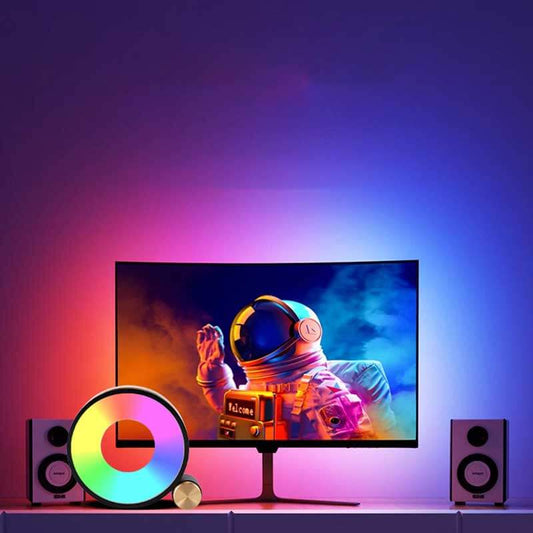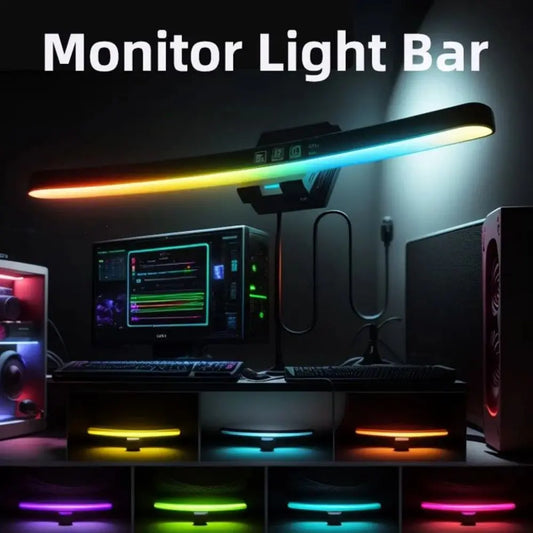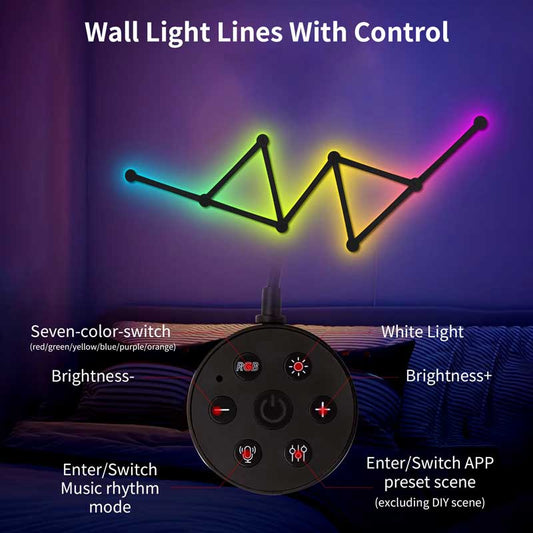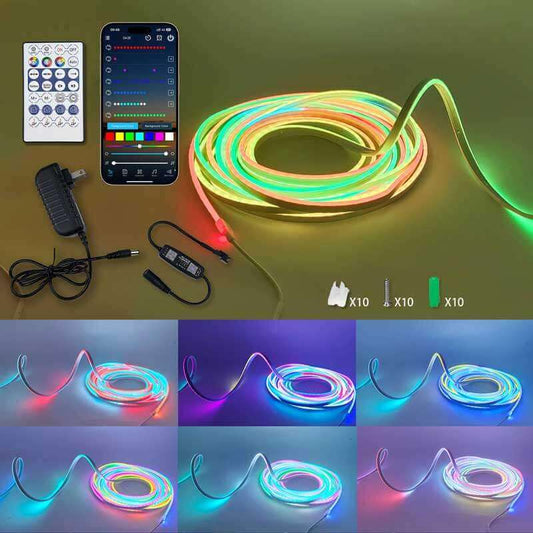4K OLED vs 4K Projector: Which is Better?
Share
The answer to whether 4K OLED is better than a 4K projector depends on your viewing preferences, environment, and budget. Both technologies offer incredible image quality, but they cater to different experiences. Let’s break down the pros and cons of each to help you decide which one is best for you.
1. Image Quality: Which Offers Superior Picture?
4K OLED
- Black Levels & Contrast: OLED TVs are famous for their deep black levels because each pixel is individually lit, meaning they can turn off completely, achieving true black. This provides an infinite contrast ratio, resulting in vivid, high-definition images.
- Color Accuracy: OLEDs are renowned for their superior color accuracy and vibrant color reproduction. They produce a wide color gamut with punchy, rich colors, ideal for watching movies, sports, and playing video games.
- Brightness: While OLEDs offer excellent contrast and color in darker rooms, they are not as bright as some projectors. They usually peak at around 500-800 nits, which is great for dark and moderately lit rooms, but they may struggle in extremely bright environments.
4K Projector
- Black Levels & Contrast: Projectors typically cannot match OLED’s black levels. They may suffer from light spill and backlight bleed, especially in rooms that are not completely dark. However, many high-end projectors have HDR support, improving their ability to handle bright whites and deep blacks.
- Color Accuracy: High-end 4K projectors can reproduce vivid colors, especially when paired with a quality projector screen. However, their color accuracy usually falls short compared to OLEDs, which offer better uniformity and color performance due to the self-illuminating pixels.
- Brightness: Projectors can offer higher brightness levels than OLEDs. For example, high-end projectors can deliver 2,000-3,000 lumens, making them ideal for large, bright rooms or environments with some ambient light. This brightness advantage makes projectors the preferred choice for screen sizes larger than 80 inches.
Verdict: OLED TVs deliver superior contrast and color accuracy in a dark room. However, projectors can offer higher brightness and larger screen sizes.
2. Size: Which One Offers a Bigger Screen?
4K OLED
- Screen Size: OLED TVs typically range from 55 inches to 77 inches, though larger models (up to 88 inches) exist. While OLED TVs provide stunning visuals, they can't compete with the sheer size that a projector can provide. The price per inch of screen size is also much higher with OLEDs.
- Viewing Distance: OLEDs generally require you to sit closer to the screen, especially for immersive viewing. For example, a 65-inch OLED would typically require you to sit about 5-7 feet away for the optimal experience.
4K Projector
- Screen Size: The primary advantage of projectors is the massive screen sizes they can produce, ranging from 80 inches to over 150 inches or more. This makes projectors perfect for creating a cinematic experience in a home theater setting.
- Viewing Distance: With a projector, you can sit much farther from the screen and still maintain an immersive experience. For a 100-inch projector screen, the ideal viewing distance is around 8-12 feet.
Verdict: Projectors offer a far larger screen size, ideal for a cinematic experience. OLEDs provide great picture quality, but their size is limited compared to projectors.
3. Performance in Different Environments
4K OLED
- Room Lighting: OLEDs are best suited for dark rooms or rooms with controlled ambient light. While they can handle some ambient light, their performance truly shines in darker environments where they can showcase their deep blacks and vibrant colors without being washed out.
- Ease of Setup: OLEDs are easy to set up and work well in regular living rooms. They don’t require specialized screens or an ideal viewing angle (although a wall-mounted TV is often best).
4K Projector
- Room Lighting: Projectors are more sensitive to ambient light, and their image quality can degrade in well-lit rooms. For the best results, you need a dark room or a dedicated home theater space to prevent light washout. Projectors perform best in rooms where you can control the lighting.
- Setup: Projectors require more space for proper setup. You’ll need a long throw distance (the distance between the projector and the screen), and the screen itself often needs to be high quality to optimize brightness and contrast. Additionally, projectors may require a ceiling mount or a specialized stand, adding to the setup complexity.
Verdict: OLED TVs are more versatile in terms of room lighting and are easier to set up. Projectors are best for dark, controlled environments where you can create the perfect cinema-like experience.
4. Price: Which One is More Affordable?
4K OLED
- Price: OLED TVs are premium products and come with a hefty price tag. A 55-inch 4K OLED can start at around $1,500, with larger models (65-inch, 77-inch) pushing prices up to $3,000-$5,000 or more. The price for OLEDs is still high due to the advanced technology that allows for true black levels and color accuracy.
4K Projector
- Price: 4K projectors can vary significantly in price. Entry-level models with decent performance start around $1,000-$2,000, but higher-end models with advanced features like laser light engines, HDR support, and higher brightness can cost anywhere from $3,000-$8,000 or more. Keep in mind that you’ll need a projector screen, which adds to the cost.
Verdict: 4K projectors are generally more affordable for large screens and can offer better value per inch. However, high-end projectors and OLED TVs are priced similarly at the top end.
5. Longevity and Maintenance
4K OLED
- Lifespan: OLED panels have a long lifespan—typically around 100,000 hours. However, they are susceptible to burn-in, especially if static images are left on the screen for long periods. This is a concern with gaming or news channels with static logos.
- Maintenance: OLEDs generally don’t require much maintenance, other than regular cleaning of the screen and occasional software updates.
4K Projector
- Lifespan: The lamp in most projectors has a limited lifespan of around 2,000-5,000 hours, depending on the model. Higher-end laser projectors can last up to 20,000 hours, but lamp replacements are still a consideration in the long run.
- Maintenance: Projectors require more maintenance, especially if you use them frequently. Dust can accumulate on the lens, and bulbs need to be replaced over time.
Verdict: OLED TVs tend to last longer without as much maintenance, but projectors require occasional bulb or lamp replacements.
Conclusion: Which Is Better—4K OLED or 4K Projector?
-
Choose a 4K OLED TV if:
- You want superior color accuracy and deep blacks for an exceptional TV watching experience.
- You prefer a smaller to medium screen size (55 inches to 77 inches).
- You have a bright room or moderate ambient light and want a device that works well in most lighting conditions.
- You want an easy-to-set-up, low-maintenance, and long-lasting TV.
-
Choose a 4K Projector if:
- You desire a massive screen size (80 inches to 150 inches or more) for a cinematic experience.
- You have a dark room or can control the lighting in your viewing space.
- You’re willing to invest in a projector screen and the extra space for setup.
- You want to experience larger-than-life visuals and don’t mind occasional maintenance (e.g., bulb replacement).
Ultimately, it’s all about your personal preference for screen size, image quality, and environment. Both offer a premium experience, but the best choice depends on whether you prioritize massive screen size or superior image quality.
1. Image Quality: Which Offers Superior Picture?
- For a deeper understanding of OLED technology and its image quality, check out LG’s guide to OLED technology:
LG OLED Technology Guide - For a review of 4K projectors and their brightness levels, check out ProjectorCentral:
ProjectorCentral - 4K Projector Reviews
2. Size: Which One Offers a Bigger Screen?
- If you’re interested in screen size comparisons and the impact on the viewing experience, you can read TechRadar’s insights on projectors and screen sizes:
TechRadar - Best Projector for Home Theater - For detailed information on OLED TV sizes, visit CNET's guide:
CNET - Best OLED TVs for 2023
3. Performance in Different Environments
- For advice on room lighting and how it affects both projectors and OLED TVs, see AVS Forum’s post on projector performance:
AVS Forum - Projector Setup Guide - To understand how OLED TVs perform in different lighting conditions, read this OLED TV guide on RTINGS.com:
RTINGS.com - OLED TV Review
4. Price: Which One is More Affordable?
- To explore the price comparison of OLED TVs versus projectors, check out Consumer Reports’ article on the topic:
Consumer Reports - Projector vs TV Price - For a deeper dive into affordable 4K projectors that deliver great value, visit Projector Reviews:
Projector Reviews - Best Budget 4K Projectors
5. Longevity and Maintenance
- For information on OLED TV lifespan and the potential for burn-in, check out DisplaySpecifications:
DisplaySpecifications - OLED TV Lifespan - For projector maintenance tips, including lamp replacement, check out this guide by Projector Central:
Projector Central - Projector Maintenance Guide
Conclusion: Which Is Better—4K OLED or 4K Projector?
By considering the pros and cons of each display technology, you can make an informed decision based on your unique needs. For more expert opinions, refer to:
-
The Verge’s article on OLED vs LED vs Projector for a broader comparison:
The Verge - OLED vs LED vs Projector -
For insights on the best 4K home theater setups (including both OLED and projector options), visit Sound & Vision:
Sound & Vision - Best 4K Home Theater Setups




